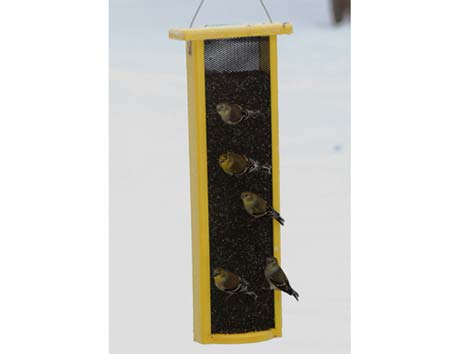

This worked in my yard for several years for Common Grackles until last year when they decided that safflower, although bitter, was still food and they were hungry, so let’s eat! Red-Winged Blackbirds, Brown-Headed Cowbirds and European Starlings eat safflower in my yard too. Try swapping out safflower for sunflower and other seed. It is possible that at least some of the visiting flock may not like/be familiar with safflower seed. If you want to continue to offer these types of seed, at least contain it so they don’t have a wide area in which to spread out to eat, making it that much more attractive to them. Also when the flocks are active, try to avoid broadcasting seed on the ground it is attractive for feeding a large flock.

If you are offering mixed seed that contains millet, milo and corn that these flocks especially like, stop. Common Grackle Option 3: No Millet, Milo or Corn If they haven’t found an alternative food source in those periods when you’ve sent them on their way, they’ll be back to your feeders. If you do this repeatedly, there is a chance they won’t return the next day. If it is cold, especially if there is a late snow, the flock will probably be back again after awhile. (The exception can sometimes be a rag-tag of a few starlings who can be incredibly tenacious.) After a few minutes, the flock will probably move off. If they haven’t, then try clapping loudly a few times.

Usually nuisance blackbird flocks are not super patient (they have a lot of mouths to feed after all.) If you stand there for a few minutes, they are likely to move on. The flock may very well wait a little to see what you will do. If the blackbird flock only retreats a little bit, try moving toward where they settle. Just stand in the feeder area for a several minutes. Don’t scream and shout and get worked up about it. Female Brown-Headed Cowbird Option 2: Be Present in the Yard with Flocksįeed the birds as usual but go outside when the flocks descend. Put the feeders back up when the weather warms up.įor myself, I can’t do this because I don’t like leaving my regular birds without this up-until-then reliable food source at a time of year when native foods tend to be scarcer. If you don’t want to feed the hoard, this is the way to be 100% effective. Some people take their feeders down until nuisance blackbird flocks go away. Blackbird Thwarting Strategies: Option 1: Take Feeders Down Different strategies can work better for different birds. The big mixed nuisance blackbird flocks typically are made up of Common Grackles, European Starlings, Brown-Headed Cowbirds and Red-Winged Blackbirds. Male Brown-Headed Cowbird Which “Blackbirds” Are A Problem At Feeders?įirst, exactly what birds are we talking about? People often use the word “blackbird” to cover a variety of black or mostly black birds. What can you do about blackbirds overrunning your feeders? Here are six strategies to get rid of annoying blackbird flocks of starlings, grackles, cowbirds and blackbirds that arrive in late winter and early spring. These flocks can take over feeders, push other birds out and eat huge amounts of seed. and a noisy aggressive mob of mixed “blackbirds” show up. You put out the regular foods in the regular bird feeders for your regular birds.

How do you get rid of a flock of nuisance “blackbirds”? Late winter to very early spring can be a stressful time of year for the backyard bird watcher. Last Updated on Octoby Nancie Red-Winged Blackbirds and Common Grackle


 0 kommentar(er)
0 kommentar(er)
